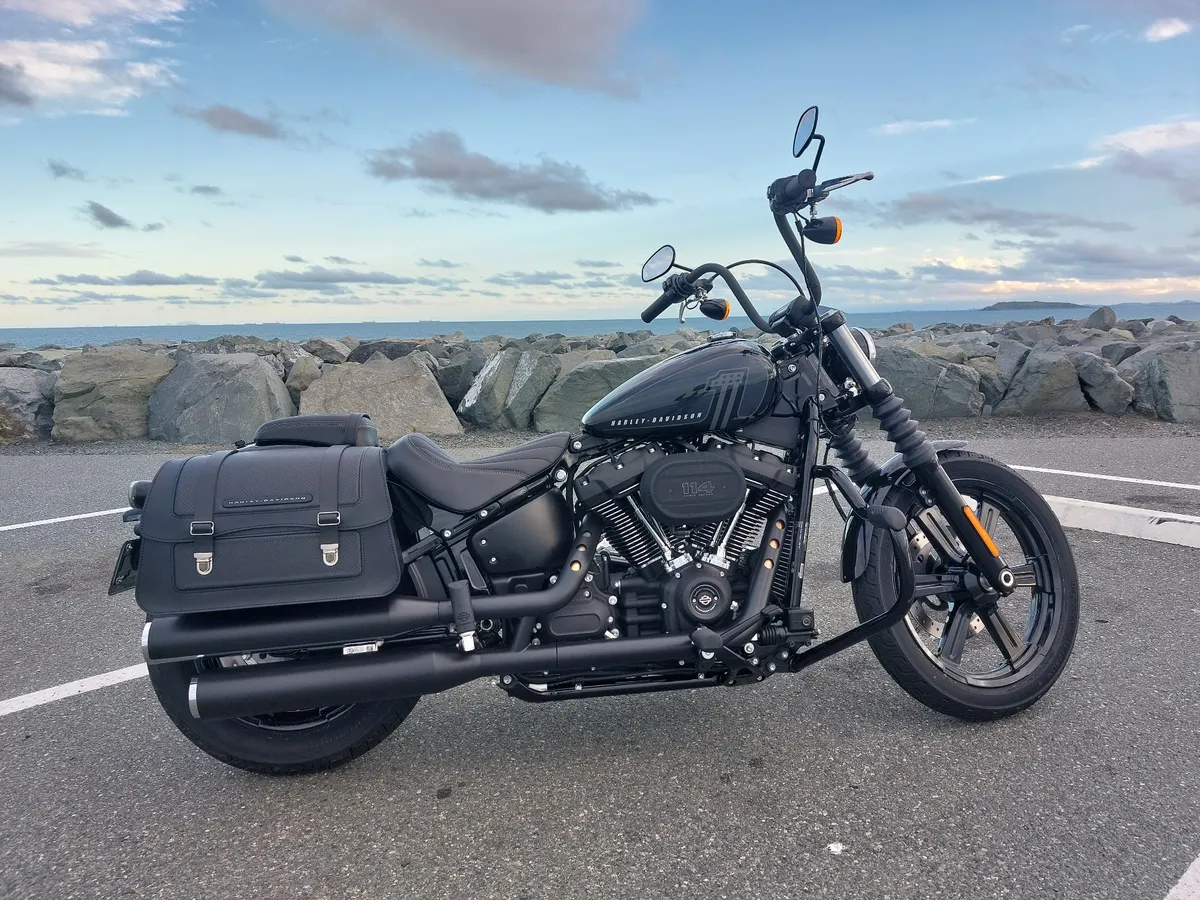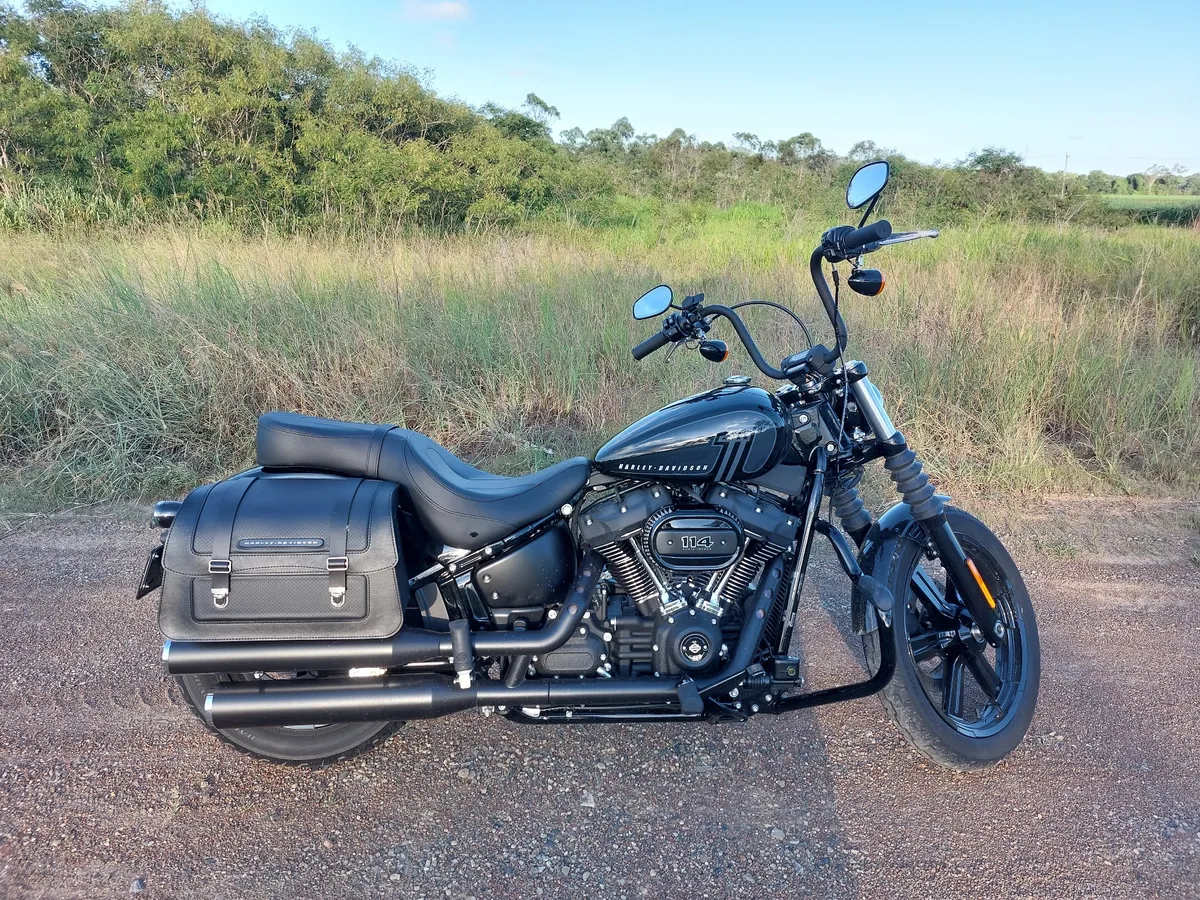Harley-Davidson Street Bob Initial Impressions
A few weeks ago, I bought my first "big bike"—a 2024 Harley-Davidson Street Bob.

Australians are limited to motorcycles of 660 cc and around 45 HP1 for their first two years of riding. I've had to wait a long time to be able to upgrade, but it's paid off—this bike is great!
After the racking up 1,600 km (1000 mi), the first service is now due. This is a great time to share my impressions so far. Here's what I like about the bike, what I don't like, and what's just OK.
What I Like
Easy to Ride
From the moment I took my first ride, I was impressed with how easy it was. The Street Bob feels so stable, especially through the corners and slow speed manoeuvres. I suppose it's the heavy weight and low centre of gravity. It's far easier to ride than the Honda CB600F I had to use during my training course.
Knees-Out Riding Position
The knees-out riding position is perfect for the Australian Summer. Gripping the tank with your knees gets sweaty fast, and you end up with sweat rashes on long trips. With the knees-out position, air circulates all around your legs and lower body, keeping you cool.
Remarkably, riding with my knees out doesn't affect the handling at all. Every other bike I've ridden felt unstable and wobbly when I don't grip the tank, especially during slow speed manoeuvres. However, the Street Bob feels perfectly planted. Once again, I wonder if this is a benefit of the heavy weight and low centre of gravity.
The Gearbox
The gearbox is a real pleasure to use. Every shift has a satisfying clunk as the bike slides into gear. I haven't hit a false neutral once yet, whereas they were common on my Hondas if you didn't shift with enough force.
And yet, I've never had a bike where it was so easy to find neutral. It's just there, whenever you want it. Apparently this is an improvement with the 2024 model year, and neutral was much harder to find beforehand. Harley-Davidson have done a great job.
Just Enough Power
I explicitly didn't want a bike with lots of power. I don't trust myself with it. And besides, Australian speed limits are low2, and police enforcement is strict.
The Street Bob produces 93 HP with its 1.8 L (114 ci) engine. More than enough to comfortably tour with a pillion and luggage - and that's all I need.
Belt Drive
Like most Harleys, the Street Bob uses a belt instead of a chain. No more oiling or mess!
Vibration
I've heard longtime Harley riders complain that the modern bikes have been "tamed" and don't vibrate like they used to. I was worried the bike would feel too smooth—maybe even smoother than my single-cylinder Hondas.
Luckily, my concern was unwarranted. The Milwaukee Eight engine loves to shake, and feels great. It definitely vibrates more than my Hondas, but it's more like big pulses than small, rapid vibrations.
Quiet Exhaust
The stock exhaust looks great, and sounds great. It's a lot louder than my other bikes', but it's not unreasonable. Just the right level for the rider to really enjoy without making your neighbours hate you.
I don't plan to change it.
Saddlebags
I bought quick-release saddlebags as an optional accessory, and they're a game-changer. They take up to 7 kg (15 lbs) of weight each, and have tonnes of room. It's actually practical to go grocery shopping now!
What I Don't Like
Stock Seat
The Street Bob's stock seat is the worst I've ever experienced. It feels nice and firm at first, but you quickly discover that it transfers every road bump into your tailbone. Long rides are horribly painful.
The pillion seat is even worse. It's way too narrow, and so hard that it might as well be a piece of wood. There's no way I'm letting my partner near it!
Luckily, there are a lot of seat options out there, including from Harley themselves. I ordered a Sundowner, and the difference is night and day. Now I can do 2+ hour rides on rough country roads in near-perfect comfort.

Turn Signal Cancellation
The Street Bob's turn signals are supposed to cancel automatically after completing a turn, but it often doesn't work. Instead, it tends to cancel too early, or not at all. This means I have to take my eyes off the road to monitor my turn signals while cornering to make sure they're still on, and afterward to make sure they're off. Not good!
I don't care for automatic cancellation anyway, and would rather disable it. Unfortunately, this doesn't seem to be supported. If you know a way to do it without making drastic modifications to the bike, please let me know!
Hard Clutch Pull
The clutch lever is hard—much harder than the small-displacement Hondas I've been riding, with their featherweight clutch levers. It's not unreasonable though, and I'm already getting used to it.
Fob and Key
This bike uses a wireless fob to start, and a key to lock the forks.
If it only used one or the other, that would be great. Having to use both is inconvenient. You lose most of the benefit of a wireless fob when you need to take the key out anyway to lock the forks when you stop.
The fob is also huge, and takes up a tonne of pocket space. I wonder if there's a smaller aftermarket housing available.
What's OK
The Jiffy Stand
The jiffy stand (kickstand) is kind of sketchy. It feels a bit loose, and doesn't really snap into place like on other bikes. When I place my bike on its jiffy stand, I have to hold it open with my foot to make sure it's fully deployed before the bike's weight is placed on it. Based on what I hear from other Harley owners, this is all normal, and the way they've been for years.
The upside is that when the jiffy stand is deployed correctly, the bike's weight locks it in place. It shouldn't collapse, even if the bike is parked facing downhill. That's pretty cool.
Ground Clearance
The Street Bob's ground clearance is pretty low at 125 mm (4.9 in). It's very easy to scrape the pegs, and it can be a bit scary if you find yourself entering a corner too fast. I'm a laid-back, slow rider so that suits me fine, but still takes some getting used to.
I'm a bit nervous about accidentally puncturing the sump when riding over speed bumps. It's been OK so far, but I'm not game to try riding up a curb yet.
All that said, I like the low ride height. I've gotten used to riding tall bikes from my Honda CRF300 Rally, but low bikes are still easier.
Fuel & Fuel Efficiency
So far, I'm getting 5-6 L/100 km (39-56 mpg). That's not bad, and matches the 5.5 L/100 km claimed by Harley-Davidson. However, it represents a much shorter range than my Honda CRF300 Rally despite having a slightly larger fuel tank.
Like most large-displacement bikes today, the Street Bob takes 95 RON (super unleaded) petrol. Unfortunately, it's not very common here in Australia.
91 RON (regular) and 98 (premium) are both easy to find though. While I can always use 98 RON if I need to, it'd be much cheaper and easier if I could use 91 RON instead.
The Smell
Today's Japanese motorcycles don't really have a smell once the manufacturing residues burn off during break-in. My Honda Grom and CRF300 Rally are basically odourless. On the other hand, the Street Bob still has that old motorcycle petrol-and-oil smell, even now.
I like that the Street Bob has a smell; like the vibrations and sound, it's part of the whole sensory experience. But it really lingers, and stinks up my whole garage for hours after I park my bike.
Conclusion
Overall, the Street Bob has been a great choice. I'm really happy with it—especially after replacing the stock seat. I'm really looking forward to road tripping with it in the future.